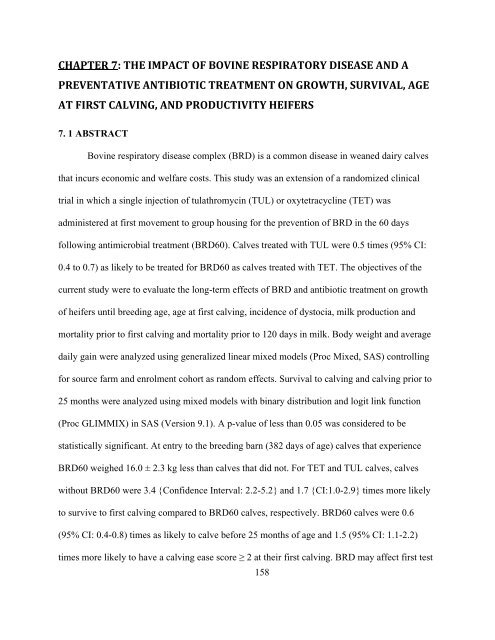Stanton PhD Thesis final_docx - Atrium - University of Guelph
Stanton PhD Thesis final_docx - Atrium - University of Guelph
Stanton PhD Thesis final_docx - Atrium - University of Guelph
You also want an ePaper? Increase the reach of your titles
YUMPU automatically turns print PDFs into web optimized ePapers that Google loves.
CHAPTER 7: THE IMPACT OF BOVINE RESPIRATORY DISEASE AND A<br />
PREVENTATIVE ANTIBIOTIC TREATMENT ON GROWTH, SURVIVAL, AGE<br />
AT FIRST CALVING, AND PRODUCTIVITY HEIFERS<br />
7. 1 ABSTRACT<br />
Bovine respiratory disease complex (BRD) is a common disease in weaned dairy calves<br />
that incurs economic and welfare costs. This study was an extension <strong>of</strong> a randomized clinical<br />
trial in which a single injection <strong>of</strong> tulathromycin (TUL) or oxytetracycline (TET) was<br />
administered at first movement to group housing for the prevention <strong>of</strong> BRD in the 60 days<br />
following antimicrobial treatment (BRD60). Calves treated with TUL were 0.5 times (95% CI:<br />
0.4 to 0.7) as likely to be treated for BRD60 as calves treated with TET. The objectives <strong>of</strong> the<br />
current study were to evaluate the long-term effects <strong>of</strong> BRD and antibiotic treatment on growth<br />
<strong>of</strong> heifers until breeding age, age at first calving, incidence <strong>of</strong> dystocia, milk production and<br />
mortality prior to first calving and mortality prior to 120 days in milk. Body weight and average<br />
daily gain were analyzed using generalized linear mixed models (Proc Mixed, SAS) controlling<br />
for source farm and enrolment cohort as random effects. Survival to calving and calving prior to<br />
25 months were analyzed using mixed models with binary distribution and logit link function<br />
(Proc GLIMMIX) in SAS (Version 9.1). A p-value <strong>of</strong> less than 0.05 was considered to be<br />
statistically significant. At entry to the breeding barn (382 days <strong>of</strong> age) calves that experience<br />
BRD60 weighed 16.0 ± 2.3 kg less than calves that did not. For TET and TUL calves, calves<br />
without BRD60 were 3.4 {Confidence Interval: 2.2-5.2} and 1.7 {CI:1.0-2.9} times more likely<br />
to survive to first calving compared to BRD60 calves, respectively. BRD60 calves were 0.6<br />
(95% CI: 0.4-0.8) times as likely to calve before 25 months <strong>of</strong> age and 1.5 (95% CI: 1.1-2.2)<br />
times more likely to have a calving ease score ≥ 2 at their first calving. BRD may affect first test<br />
158

















